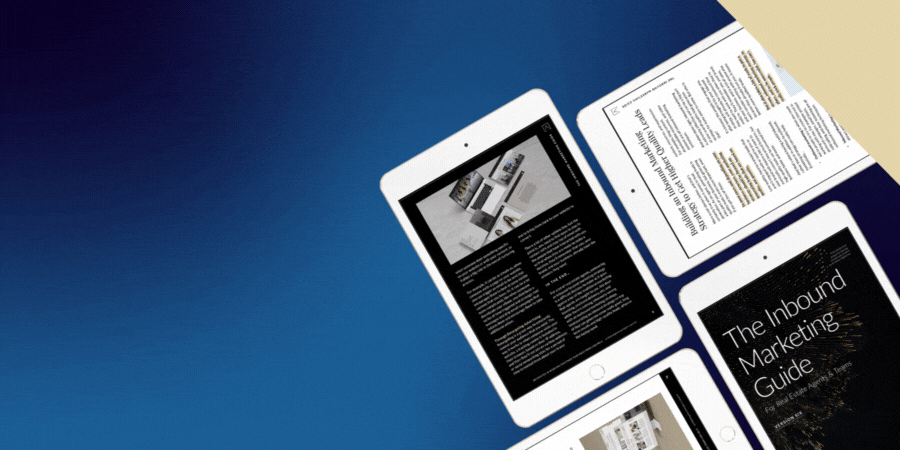What if you could build a quality list of contacts within your ideal target audience that reach out to you when they’re ready to buy, sell, or have a real estate question? You can, through developing an inbound marketing strategy.
First, let’s clarify what inbound marketing is, and how it differs from an outbound marketing strategy (which is what most real estate agents do):
- Outbound Marketing is a cold reach out to people to try to create interest in them working with you. For example: print postcard campaigns, cold email blasts, cold calling, and door-knocking are all outbound marketing techniques.
- Inbound Marketing is when is when you attract and build meaningful, lasting connections and relationships with people through providing valuable content, resources, and experiences. For example, blog content, downloadable resources, and video content are all inbound marketing techniques.
Inbound marketing works because it builds trust, and if it’s set up correctly, then it can often run in the background, 24 hours a day, without you even knowing it. Quality leads will just eventually reach out.
The inbound marketing approach is all about casting a wide, quality driven net, so people discover you and your business in a number of different places (like through SEO-driven content, ads to download resource materials, etc), and then become part of your community and/or your database.
Once they’re part of your database, the lead nurturing aspect of the inbound marketing approach kicks in, and they continually get nurtured by your business until they’re ready to work with you, which hopefully if you’ve built enough trust and authority, they’ll reach out to you for.
The general idea of inbound marketing follows 3 main stages:
1. Attract: In stage 1, you attract your audience by allowing them to discover you online by providing valuable content and building conversation (often multiple times), so you establish yourself as an authority.
For example, you could produce a content strategy that answers questions potential sellers may have about the process of down-sizing. When someone searches online for answers to their questions, if you continually show up in search results and they read your content, they’ll:
- Initially discover you and your content,
- Get answers to their questions
- Associate you with being the authority on down-sizing because you’ve helped them
★ The attract stage is deeply routed in quality content that’s often planned around an SEO and content strategy. If you need more information about that, have a look at these posts:
- Building a Well-Rounded SEO Search Strategy for Your Real Estate Website
- How to Start Building a Solid Real Estate Local SEO Strategy
- Planning a Successful Content Strategy for Your Real Estate Website
- Optimizing Your Content for Humans (And Not Just for Search Engines)
- Download our SEO Strategy Building Guide for Real Estate Agents
2. Engage: In stage 2, you create conversation with your audience that has now discovered your content, often through a lead nurturing strategy. This allows you to build an initial relationship with people, so that they continually see you as being helpful as part of their search process. A lot of this can be done through automation.
For example, if someone is looking for information about down-sizing, and finds your content in stage 1, you can give them the option to sign up for your marketing email through a CTA, to give them more, up-to-date information about the down-sizing process specifically and how to better prepare for it.
Or another approach could be to install a chatbot, on each of the pages of content directly related to down-sizing, that asks the person if they have any questions about down-sizing specifically to see if they’d like to set up a call about it; having a chatbot that directly addresses down-sizing on content specifically related to it, is much more effective (and engaging) then one that simply asks if they have any general questions.
★ The engage stage is routed in your marketing automation and lead nurturing strategy. If you need more information about that, have a look at these posts:
- Leveraging Marketing Automation as Part of Your Real Estate Lead Generation Strategy
- Download our Lead Nurturing Guide for Real Estate Agents
3. Delight: In stage 3, you build on the general engagement stage by making things more personal and directly related to the person you’re engaging, which allows you to build a personal relationship with them.
The delight stage is all about delivering the right information, to the right person, at the right time. If someone has already been through the stages above and is now part of your database, then you can set up email marketing automation triggers that are personal to them based on what they’re doing.
For example, after you’ve established yourself as an authority, if that same person that’s thinking about downsizing visits your (now familiar) website again decides that they want to learn more about you to see if you’re the right fit to help them, and to help determine that, they visit a page on your website about you, your team, or your testimonials, you can trigger a customized email to them that explicitly goes through why you’re the best choice.
- If you want to see this in action (and you’re part of our database because you’ve already downloaded one of our free resources) you can just visit our Results page right here, and an email will show up in your inbox telling you more about us.
★ If you want to learn more about how to build an inbound marketing strategy, have a look at this post right here.
Inbound marketing, when set up correctly and methodically, can truly feel and work like magic. It helps people discover you when they need something, showcases you as the authority on the subject, and then nurtures them generally and eventually more personally. If all goes well, eventually, they’ll reach out when they’re ready to make a decision, and in a lot of cases, they won’t reach out to anyone else because you’ve already built something with them that can’t be bought through other avenues of marketing: real and true trust.
★ The inbound marketing philosophy was originally established by HubSpot; if you want to do a deeper dive into the philosophy of inbound marketing, you can do that right here.
Want to get better, more qualified leads and build your authority? Our Inbound Marketing Guide is a walkthrough of the overall philosophy of inbound marketing, why it’s effective, and how you can build it into your own real estate marketing strategy to get better marketing results.




